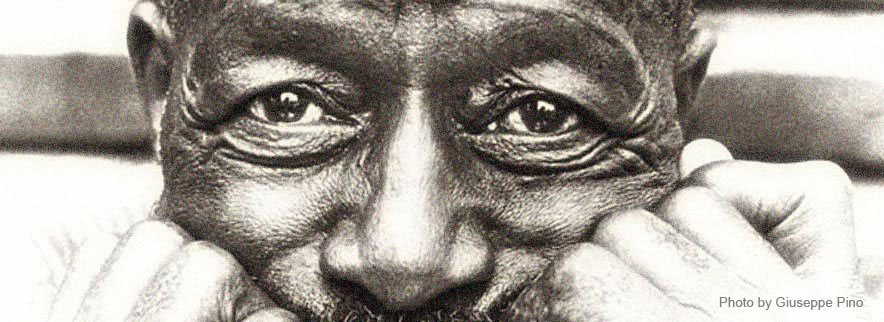I am at this moment reading a biography of Sister Rosetta Tharpe. Historically she lives in the shadow of the better known gospel singer Mahalia Jackson, who is considered to be the queen of the gospel. I don’t want to discuss if the latter is true or not. I’m not familiar with the work of Mahalia Jackson, I only know part of the repertoire of Sister Rosetta Tharpe, who I can appreciate however for many reasons. She has helped to pave the way for the R&R and she was unique as an artist combining being a woman, a magnificent singer, black and bringing a religious message using as none other what was considered to be a devil’s instrument (and moreover seen as a typical male instrument) : the (acoustic and electric) guitar.
The point however here is that her career follows clearly the great historical movement of the decline of interest in blues beginning of the fifties, coming in the shadow of R&B first and R&R after. Then, she is again picked up in the sixties via the European blues aficionados, lead a.o. by Chris Barber, who on his own budget financed the promotion of quite some African American blues singers in the UK (and afterward in Europe) (Leadbelly, Big Bill Broonzy, Muddy Waters, Sister Rosetta Tharpe, …).
Also, Son House was picked up again in 1964, to be precisely on June 23rd. He was already somewhat behind in the queue of blues roots artists to be rediscovered since Samual Charters published his “The Country Blues” in 1959. Imagine the excitement of those white, liberal, middle-class boys collecting scratchy 78-records from the twenties and thirties to find out that some of those artists were still alive and kicking ! This happened to Skip James, Bukka White, Sleepy John Estes, Furry Lewis and Lightnin’ Hopkins and John Hurt.
Son House was not that easy to find, but finally after thousands of miles and using vague leads, Dick Waterman, Phil Spiro and Nick Perls found Son House in Rochester on 23/6/1964.
Waterman, who received a journalist education at the Boston University in the 50ties, became an editor of the Broadside Magazine, and made his live of promoting blues artists later on. He was also the one that guided Bonnie Raitt to success. Nick Perls, audio-engineer, and serious collector of 78-oldies, became later the driving force behind Yazoo-records which managed to publish and preserve for the future generations a great collection of blues originals. Spiro was the friend of Al Wilson (later best known as the voice of Canned Heat : On the road again & Goin’ up the country), who didn’t participate in the search for Son House as he was expecting to be offered some gigs in Cambridge.
Finding the blues roots artists was of course a matter of urgency. Generally, blues artists die young and it was not sure whether Son House was still alive or not. After a search of sixteen days which brought them from the Southern Mississippi to New York they finally got a tip that Son House might be residing in Greig street, Rochester, where he had been since he left the Mississippi Delta after the recordings done by Alan Lomax. At first it took some phone calls, but finally Son House rang the trio to invite them to his apartment in Rochester. And : he was prepared to go back on the music scene. Note that he was not aware that there was any blues revival going on, nor that his own music was very much wanted in this revival. He must have been very puzzled by the fact that people were looking for him for his musical talents which he had for some years now put aside.
This discovery even made the news in newspapers as the National Observer and Newsweek (I attach copies of both).
But taking up a musical career was not at all an easy thing to do. Son House suffered from a senile hand tremor, which combined with his strong alcoholism made guitar playing extremely difficult. Saying that he was prepared to take up the guitar again on stage and in the studio, was one thing; making him ready to do it, was another thing. Physically he was not ready for it : being sober, he didn’t do very much, being drunk, the music came back, but it was difficult to keep him on the agenda and make him say sensible things on stage.
Medication and the enthusiastic energy invested by Al Wilson however gradually got him back on the track. Slowly the songs would come back into his mind, and Al Wilson practiced intensely with him to show him how he used to play the blues in those grand old days. Some say that it was Al Wilson that taught Son House to play again like Son House; others say that he merely brushed off the thick layer of dust that lay on his musical talent.

(photograph, left to right : Nick Perls, Dick Waterman, Son House, Phil Spiro)
Anyhow, by April 1965 he was ready to go back to the studio. Columbia Records had invited him to have a recording produced by John Hammond. Hammond was also a music critic and talent scout. The list of his promotion output is long, and should say enough about the fine nose he had for talent : a.o. Benny Goodman, Billie Holiday, Count Basie, Big Joe Turner, Pete Seeger, Aretha Franklin, George Benson, Bob Dylan, Freddie Green, Leonard Cohen, Bruce Springsteen, and Stevie Ray Vaughan.
This recording session has become historical, but that is something to elaborate on in one of my coming blogs.
– article in Blues Access
– article in Newsweek
– article in The National Observer

